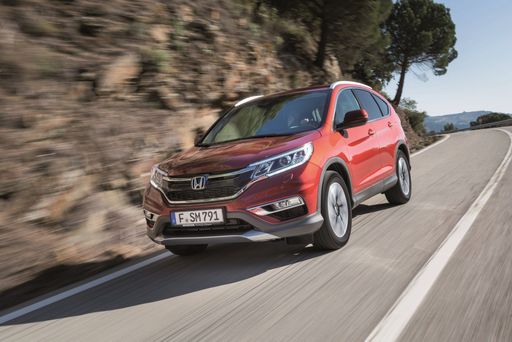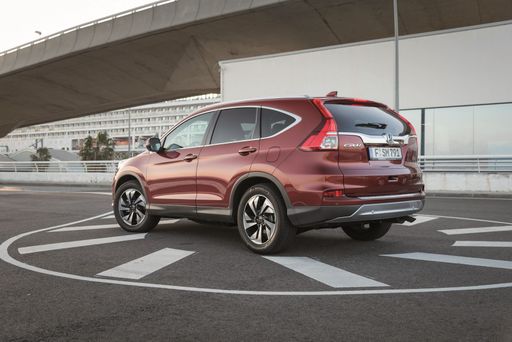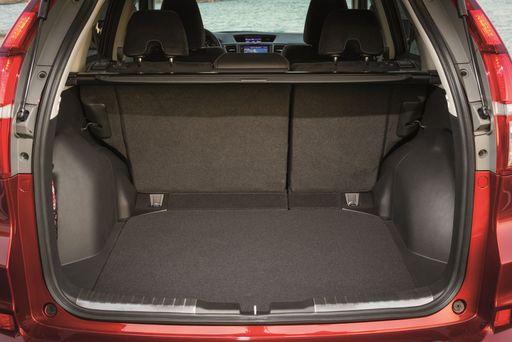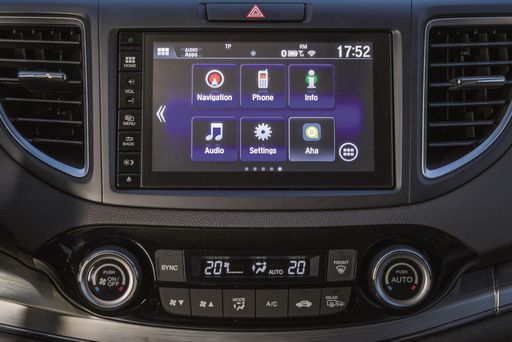Honda CR-V VS Renault Trafic Bus – Specs, Efficiency & Price Comparison
Which model is the better choice – the Honda CR-V or the Renault Trafic Bus? We compare performance (184 HP vs 150 HP), boot capacity (617 L vs ), efficiency (0.80 L vs 6.80 L), and of course, the price (42500 £ vs 38200 £).
Find out now which car fits your needs better!
The Honda CR-V (SUV) is powered by a Full Hybrid or Plugin Hybrid engine and comes with a Automatic transmission. In comparison, the Renault Trafic Bus (Bus) features a Diesel engine and a Manuel gearbox.
When it comes to boot capacity, the Honda CR-V offers 617 L, while the Renault Trafic Bus provides – depending on what matters most to you. If you’re looking for more power, you’ll need to decide whether the 184 HP of the Honda CR-V or the 150 HP of the Renault Trafic Bus suits your needs better.
There are also differences in efficiency: 0.80 L vs 6.80 L. In terms of price, the Honda CR-V starts at 42500 £, while the Renault Trafic Bus is available from 38200 £.
Compare all the key specs now and find out which model fits your lifestyle best!
Honda CR-V
The Honda CR-V presents a blend of practicality and comfort, making it a reliable choice for families and adventure seekers alike. With its spacious interior and refined design, it offers a pleasant driving experience whether in urban environments or on long road trips. This model also boasts a range of advanced safety features, enhancing driver confidence and passenger security.
details @ hondanews.eu
@ hondanews.eu
 @ hondanews.eu
@ hondanews.eu
 @ hondanews.eu
@ hondanews.eu
 @ hondanews.eu
@ hondanews.eu
Renault Trafic Bus
The Renault Trafic Bus is a versatile and spacious option for those needing to transport multiple passengers comfortably. With its modern design and practical features, it is well-suited for both business and leisure purposes. Its efficient engine and smooth handling make it a reliable choice for long journeys.
details

|
|
|
|
|
Costs and Consumption |
|
|---|---|
|
Price
42500 - 52100 £
|
Price
38200 - 51100 £
|
|
Consumption L/100km
0.8 - 6.7 L
|
Consumption L/100km
6.8 - 7.2 L
|
|
Consumption kWh/100km
-
|
Consumption kWh/100km
-
|
|
Electric Range
79 km
|
Electric Range
-
|
|
Battery Capacity
-
|
Battery Capacity
-
|
|
co2
18 - 152 g/km
|
co2
179 - 188 g/km
|
|
Fuel tank capacity
46 - 57 L
|
Fuel tank capacity
80 L
|
Dimensions and Body |
|
|---|---|
|
Body Type
SUV
|
Body Type
Bus
|
|
Seats
5
|
Seats
8 - 9
|
|
Doors
5
|
Doors
4
|
|
Curb weight
1821 - 1988 kg
|
Curb weight
2031 - 2321 kg
|
|
Trunk capacity
579 - 617 L
|
Trunk capacity
-
|
|
Length
4706 mm
|
Length
5080 - 5480 mm
|
|
Width
1866 mm
|
Width
1956 mm
|
|
Height
1673 - 1684 mm
|
Height
1973 - 1974 mm
|
|
Payload
439 - 475 kg
|
Payload
749 - 982 kg
|
Engine and Performance |
|
|---|---|
|
Engine Type
Full Hybrid, Plugin Hybrid
|
Engine Type
Diesel
|
|
Transmission
Automatic
|
Transmission
Manuel
|
|
Transmission Detail
-
|
Transmission Detail
Schaltgetriebe
|
|
Drive Type
All-Wheel Drive, Front-Wheel Drive
|
Drive Type
Front-Wheel Drive
|
|
Power HP
184 HP
|
Power HP
110 - 150 HP
|
|
Acceleration 0-100km/h
9 - 9.5 s
|
Acceleration 0-100km/h
13.6 - 16.5 s
|
|
Max Speed
187 - 195 km/h
|
Max Speed
161 - 174 km/h
|
|
Torque
335 Nm
|
Torque
300 - 350 Nm
|
|
Number of Cylinders
4
|
Number of Cylinders
4
|
|
Power kW
135 kW
|
Power kW
81 - 110 kW
|
|
Engine capacity
1993 cm3
|
Engine capacity
1997 cm3
|
General |
|
|---|---|
|
Model Year
2024
|
Model Year
2023 - 2024
|
|
CO2 Efficiency Class
E, D, B
|
CO2 Efficiency Class
G
|
|
Brand
Honda
|
Brand
Renault
|
Honda CR-V
Introducing the Honda CR-V: A Modern Marvel in the SUV Realm
Bursting onto the scene with cutting-edge innovation and engineering brilliance, the Honda CR-V continues to mesmerise car enthusiasts and potential buyers alike. As a staple of the SUV segment, the Honda CR-V offers a versatile blend of performance, efficiency, and technology for the discerning driver.
Innovative Powertrains: Hybrid and Plug-In Hybrid Excellence
The heart of the Honda CR-V lies in its advanced hybrid and plug-in hybrid powertrains, featuring a 2.0-litre i-MMD (intelligent Multi-Mode Drive) engine. Producing an impressive 184 PS (135 kW) of power, this system offers robust acceleration, reaching 0-100 km/h in as little as 9 seconds. Depending on the model variant, drivers can choose between front-wheel drive and all-wheel drive configurations, with fuel efficiency ranging from 0.8 L/100 km for the plug-in hybrid to 6.7 L/100 km for the hybrid models. Additionally, the plug-in hybrid version provides an all-electric range of 79 kilometres, ideal for urban commutes.
Masterful Design and Practicality
Measuring 4,706 mm in length and 1,866 mm in width, the CR-V maintains a commanding presence on the road. The vehicle combines sleek aesthetics with practical design, boasting a spacious cabin that comfortably seats five occupants. With a boot capacity extending from 579 to 617 litres, the CR-V offers ample storage for both everyday tasks and grand adventures.
Advanced Technological Features for a Safer Drive
Safety and convenience remain paramount in the latest Honda CR-V, equipped with state-of-the-art technology. The inclusion of Honda SENSING, a suite of driver-assistance systems, ensures enhanced awareness and minimises the risk of accidents. From adaptive cruise control to lane-keeping assist, these features provide peace of mind during every journey.
Efficiency and Environmental Responsibility
Emphasising environmental consciousness, the Honda CR-V models boast a CO2 efficiency class spanning from B to E, with emissions as low as 18 g/km. This aligns with Honda's commitment to reducing environmental impact while providing top-tier performance.
A Premium Driving Experience
Inside, the Honda CR-V presents a refined yet functional interior, with a focus on driver comfort and connectivity. Options include luxurious upholstery, state-of-the-art infotainment systems, and ergonomic controls, ensuring an enjoyable driving experience. Available across various equipment lines such as Advance and Elegance, buyers are given a spectrum of choices to suit individual tastes and requirements.
Conclusion: The Future Looks Bright for Honda CR-V
The 2024 Honda CR-V stands as a testament to Honda's pursuit of excellence in automotive design and engineering. With its hybrid and plug-in hybrid variants, sophisticated safety technologies, and premium features, it signifies a new era of efficiency and innovation. Offering a diverse range of specifications and styles, the CR-V is well-equipped to meet diverse consumer demands, continuing its legacy as a leader in the SUV market.
Renault Trafic Bus
A Glimpse into the Renault Trafic Bus: An Icon of Versatility and Innovation
Amongst the plethora of vans designed for both business and leisure, the Renault Trafic Bus stands out as an exemplar of functionality, innovation, and style. Let's delve into what makes the Renault Trafic Bus a popular choice in the UK and across Europe, particularly focusing on its technical specifications and state-of-the-art features.
Performance Dynamics: Power Under the Hood
The Renault Trafic Bus, a staple in Renault's fleet, is driven by a robust diesel engine configuration with power outputs ranging from 110 PS to a formidable 170 PS. The diesel engines combine efficiency and power, offering torque figures between 300 to 380 Nm, ensuring smooth power delivery and capable load hauling.
Drivers can choose between manual and automatic transmissions, both designed to complement the Trafic's front-wheel-drive system. This flexibility ensures that drivers experience enhanced driving comfort whether they are navigating urban roads or cruising on the motorway.
Efficiency Meets Economy
The Trafic Bus showcases impressive fuel economy with consumption figures ranging from 6.8 to 7.2 litres per 100 kilometres. This efficiency is crucial for businesses aiming to minimise operational costs and for families seeking budget-friendly travel options.
With a generous fuel tank capacity of 80 litres, the Renault Trafic Bus is built to cover long distances with fewer fuel stops, making it an ideal choice for long haul journeys.
Technological Innovations and Comfort
The Trafic Bus isn't just about robust performance. Renault has integrated a suite of technological innovations designed to enhance driver and passenger comfort. Its cabins are equipped with the latest infotainment systems and safety technologies, providing an optimal blend of comfort and convenience.
The various trims, such as Life, Start, Spaceclass, and their respective EDC variants, cater to different needs and preferences, ensuring that customers can find the perfect configuration for their requirements.
Design and Dimensions: Space for Every Purpose
Space and versatility are at the heart of the Trafic Bus design. With its dimensions ranging from a length of 5080 to 5480 mm, and a width of 1956 mm, this vehicle offers ample room for passengers and cargo alike. The height stands between 1973 and 1974 mm, ensuring that even taller individuals can travel comfortably.
With seating for up to eight people and a payload capacity between 730 to 1010 kg, the Trafic Bus can transform seamlessly between a people-mover and a goods carrier.
Environmental Considerations
Renault has engineered the Trafic Bus with environmental responsibility in mind. The CO2 emissions range from 178 to 190 g/km, which, while modest for its class, aligns with the efficiency and performance goals set for this versatile vehicle. The CO2 efficiency class is rated as 'G', offering transparency in its environmental impact profile.
Conclusion: A Leader in Its Class
The Renault Trafic Bus continues to lead its segment through a blend of power, efficiency, and technological advancements. Whether it's for commercial transport or family adventures, the Trafic offers a reliable and adaptable solution, setting a high standard for multi-purpose vehicles.
For those seeking a distinguished blend of utility and comfort, the Renault Trafic Bus emerges as an exceptional choice, promising performance and innovation on every journey.
The prices and data displayed are estimates based on German list prices and may vary by country. This information is not legally binding.
